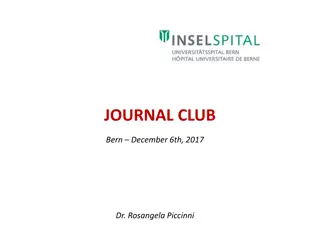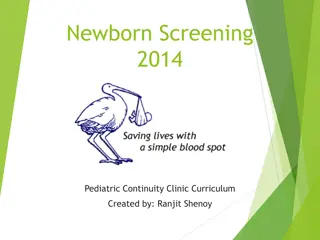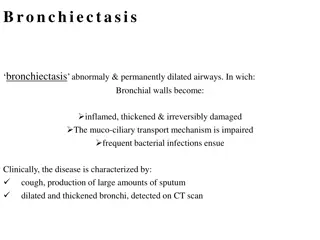Understanding Steatotic Liver Disease: Importance, Epidemiology, and Pathology
Steatotic liver disease, including metabolic dysfunction associated steatohepatitis (MASLD) and metabolic associated alcoholic liver disease (MALD), is a common cause of liver test abnormalities in the United States. Risk factors such as obesity and metabolic syndrome can lead to advanced fibrosis a
2 views • 44 slides
Understanding Liver Complications in Cystic Fibrosis: Latest Insights for 2024
Liver complications in cystic fibrosis (CF) have gained importance due to CFTR modulators impacting liver health. This presentation by Dr. Zachary M. Sellers delves into new definitions for CF liver disease, CFF recommendations for screening, management, and treatment of hepatobiliary issues in CF.
0 views • 17 slides
Understanding the Impact of Sustained Stress on Health and Well-being
This presentation explores the effects of sustained stress on the body, particularly in the context of caring for individuals with chronic conditions like cystic fibrosis. It delves into the physiological responses to stress, the unavoidable stressors faced by caregivers, and the detrimental impacts
1 views • 14 slides
Understanding Nontuberculous Mycobacteria Infections in Cystic Fibrosis
Nontuberculous mycobacteria (NTM) infections present a significant challenge in individuals with cystic fibrosis (CF). These infections are caused by over 200 species of atypical mycobacteria found in various environments. The CF-ID Clinic plays a crucial role in managing patients with multi-drug re
2 views • 25 slides
Cystic Fibrosis:The Modulator Era
Cystic Fibrosis (CF) is a genetic disease caused by variants in the CFTR gene. CFTR is a crucial membrane protein responsible for chloride transport in epithelial cells, impacting organ function. The Modulator Era focuses on CFTR modulators approved by the FDA for treating CF and improving outcomes.
0 views • 63 slides
New Drugs and Clinical Edits Overview in MO HealthNet Pharmacy Program
Explore the latest pharmaceutical additions and clinical edits in the MO HealthNet Pharmacy Program for various conditions like Fabry disease, cystic fibrosis, generalized myasthenia gravis, and more. Discover new medications such as Elfabrio, Kalydeco, Rystiggo, and Trikafta along with their indica
1 views • 19 slides
Overview of Human Genetic Disorders
Human genetic disorders encompass a range of conditions, from recessive disorders like cystic fibrosis to dominant disorders such as Huntington's disease. Examples include cystic fibrosis, Huntington's disease, and sickle-cell anemia. Understanding genetic disorders involves research and awareness o
0 views • 10 slides
Optimizing Respiratory Therapy for Adult Cystic Fibrosis Patients
Creating an effective daily respiratory therapy regimen is crucial for adults with Cystic Fibrosis (CF) to maintain healthy lungs and good lung function. This includes inhaled medications such as nebulizer treatments and bronchodilators, airway clearance techniques like the Vest and Pep devices, as
0 views • 32 slides
Endovascular Stenting for Superior Vena Cava Occlusion: A Case Study
Superior Vena Cava (SVC) occlusion secondary to postradiation fibrosis is a rare condition that can lead to debilitating symptoms. In this case study, a 47-year-old male with a history of Hodgkin lymphoma treated with chest radiotherapy presented with exertional chest pain and other associated sympt
1 views • 19 slides
Understanding the Derivation of the Nernst Equation and Its Implications
The Nernst Equation is derived to provide insight into membrane potential and its role in various health conditions like cystic fibrosis and epilepsy. This derivation involves combining diffusive flux, electric drift, and mobility terms, leading to a deeper understanding of membrane behavior. The Bo
1 views • 26 slides
Understanding Genetics: Part 2 - Cystic Fibrosis, Family Pedigrees, and Sex-Linked Genetic Disorders
Genetics is a fascinating field that influences our health and traits. Part 2 of our guide explores topics such as cystic fibrosis, family pedigrees, and sex-linked genetic disorders. Learn about the inheritance patterns, carrier statuses, and implications of these genetic conditions through detaile
0 views • 15 slides
Comprehensive Pre-Treatment Assessment for Chronic Hepatitis C in Adults
Core trainers in CPG management of Chronic Hepatitis C in adults must focus on pre-treatment assessment to identify co-morbidities, assess liver status, determine fibrosis severity, and conduct necessary blood investigations. Utilizing non-invasive methods for liver fibrosis assessment is crucial fo
0 views • 13 slides
Understanding Gene Therapy: Types, Techniques, and Applications
Gene therapy involves introducing DNA into a patient to treat genetic diseases by correcting disease-causing mutations. There are two types of gene therapy: somatic gene therapy and germline gene therapy, each with different implications. Techniques such as gene augmentation therapy and gene inhibit
1 views • 15 slides
Understanding Echinococcus Granulosus and Hydatid Disease
Echinococcus Granulosus, also known as the hydatid worm or dog tapeworm, causes cystic echinococcosis. The tapeworm has distinct characteristics and a complex life cycle involving canids as definitive hosts and humans as accidental hosts. Hydatid disease in humans can be dangerous, with symptoms var
0 views • 8 slides
Advances in Hepatitis C Treatment for HIV-Infected Patients: A Comprehensive Overview
Explore the latest advancements in the treatment of Hepatitis C virus (HCV) in HIV-infected individuals through a detailed presentation by Dr. Kara W. Chew. Learn about the initial evaluation for HCV, treatment options for different genotypes, management of advanced fibrosis, recommended approaches
0 views • 9 slides
Complex Radiology Case: Multiple Traumatic Injuries in an Elderly Female
A 77-year-old female presented with multiple traumatic injuries after falling headfirst down stairs. Imaging revealed a comminuted inferior orbital wall fracture, facial lacerations, spinal fractures, and cervical cord syndrome. Lab findings indicated preexisting conditions like osteopenia, hyperten
0 views • 18 slides
Understanding Echinococcosis: Symptoms, Transmission, and Treatment
Echinococcosis, a zoonotic disease caused by tapeworm parasites, has various forms such as cystic and alveolar echinococcosis. The disease is transmitted to humans through contaminated soil, water, or food. Diagnosis involves imaging techniques and serologic tests. Treatment options include surgery,
0 views • 9 slides
Rare Case Report of Dual Thyroid Ectopia in a Young Female
An 18-year-old female presented with a large cystic swelling in the anterior aspect of her neck, leading to the diagnosis of dual thyroid ectopia. Imaging studies, including ultrasound and CT scan, revealed ectopic lingual thyroid and a complex thyroglossal cyst. The patient underwent thyroglossal c
1 views • 8 slides
Understanding Choledochal Cysts: A Congenital Anomaly of the Biliary Tract
Choledochal cysts are congenital anomalies of the biliary tract characterized by cystic dilatation at various segments. They can lead to complications like biliary cirrhosis and recurrent pancreatitis. Clinical features include jaundice, abdominal pain, and right epigastric mass. Early detection is
0 views • 22 slides
Understanding Reproductive Disorder Diseases and Hormonal Infertility in Simple Language
Reproductive disorders can lead to infertility or sterility in animals, affecting their ability to reproduce. Causes include anatomical, functional, infectious, and management factors. Hormonal infertility may result from issues like cystic ovaries, delayed ovulation, or inactive ovaries. Conditions
0 views • 14 slides
Understanding the Impact of Secondhand Smoke on Infants with Cystic Fibrosis
Studying infants with cystic fibrosis exposed to secondhand smoke revealed that those in smoke-free homes experienced better growth and lower risk of bacterial infections compared to those with smoking parents. Creating a quit plan for smokers is essential to improve health outcomes and prevent rela
2 views • 25 slides
Retinal Imaging Conference - Case Study of Diabetic Patient with Blurry Vision
A 52-year-old African American female with a history of diabetes and hypertension presented with occasional blurry vision in her left eye. Examination revealed retinal thickening, cystic spaces, and disruption of retinal layers. Autofluorescence imaging showed hyperautofluorescence centrally and hyp
0 views • 27 slides
Understanding Tissue Repair Mechanisms: Regeneration and Fibrosis
Tissue repair involves complex mechanisms like regeneration by parenchymal cells or fibrosis leading to scar formation. Inflammatory cells play a crucial role in tissue repair, along with processes like ECM synthesis and cell migration. Different types of cells in the body have varying regenerative
0 views • 20 slides
Understanding Tissue Repair: Regeneration and Fibrosis Mechanisms
Tissue repair involves two primary mechanisms: regeneration, where some tissues can replace damaged cells, and fibrosis, where scar tissue forms if regeneration is not possible. Cell proliferation, growth factors, and cell population control play key roles in the restoration of tissue architecture a
0 views • 15 slides
Breathing Exercises for Pulmonary Health
Breathing exercises are essential interventions for managing pulmonary disorders like COPD, cystic fibrosis, and post-operative complications. They help improve ventilation, cough effectiveness, muscle strength, and reduce stress. Different types of exercises like diaphragmatic breathing and pursed
0 views • 13 slides
Improving Nutrition Goals for Children with CF
Optimizing growth and weight gain is crucial for children with cystic fibrosis (CF) to enhance health outcomes and survival. Behavioral barriers often hinder patients from achieving nutrition goals, but interventions combining nutrition and behavioral strategies have shown effectiveness. This approa
0 views • 27 slides
Understanding Cystic Fibrosis: Causes, Symptoms, and Treatment Options
Cystic Fibrosis (CF) is a genetic condition affecting around 11,000 people in the UK. It disrupts salt and water movement in cells, leading to thicker, stickier mucus in the body. This condition can affect the lungs, digestive system, and pancreas, with symptoms such as chronic cough, digestive issu
0 views • 23 slides
Understanding Genetic Disorders and the Human Genome Project
The Human Genome Project, completed in 2003, aimed to identify all human genes and DNA sequences. Genetic disorders, like autosomal disorders and Huntington's disease, can result from mutations at different levels, affecting single genes, chromosomes, or multiple genes. Albinism and cystic fibrosis
0 views • 37 slides
Prediction of Liver Fibrosis in NAFLD Patients: Impact of CAP Values
Steatosis has emerged as a significant diagnosis with NAFLD becoming a common cause for hepatologic evaluation. Liver stiffness measurement (LSM) using transient elastography is vital for assessing fibrosis severity in NAFLD patients. However, the accuracy of LSM can be influenced by obesity and sev
0 views • 35 slides
Innovative Technology for Diagnosing and Managing Respiratory Diseases
Monash University researchers have developed a groundbreaking non-invasive technology to diagnose and manage respiratory lung diseases, such as cystic fibrosis and lung cancer. The technology, utilizing four-dimensional X-ray velocity imaging, provides high-definition real-time images of airflow in
0 views • 4 slides
Newborn Screening 2014: Overview of Conditions and Management
The Pediatric Continuity Clinic Curriculum for Newborn Screening 2014 aims to increase familiarity with disorders tested in Florida Newborn Screening and manage abnormal results effectively. The presentation covers the goal of NBS, common diagnoses, resources for managing abnormal screens, and speci
0 views • 34 slides
Stanford Adult CF Patient & Family Advisory Council Initiatives
The Stanford Adult CF Patient & Family Advisory Council (CF-PFAC) is actively involved in projects aimed at enhancing the patient and family experience at Stanford Health Care and the Cystic Fibrosis Center. Initiatives include creating a memorial space, detailing the journey to transplant, capturin
0 views • 12 slides
OSCE Suggested Answers May 2016
This presentation covers a series of OSCE case scenarios along with suggested answers. Topics include abdominal aortic aneurysm, purple urine bag syndrome, cystic lesions in the cranial fossa, opioid and anticholinergic overdoses, lung collapse, and more. Detailed solutions and management plans are
0 views • 11 slides
Comprehensive Overview of Craniopharyngioma: History, Pathology, and Treatment Considerations
Craniopharyngioma is a complex intracranial tumor with a rich historical background dating back to the early 20th century. Initially described by McLean, Frazier, Alpes, and famously studied by Cushing, this tumor continues to be a subject of debate and controversy in terms of treatment approaches a
0 views • 76 slides
Understanding Bronchiectasis: Causes, Symptoms, and Diagnosis
Bronchiectasis is a condition characterized by abnormal and permanently dilated airways, often resulting in chronic cough, copious sputum production, and frequent bacterial infections. The disease can be congenital or acquired, with causes ranging from cystic fibrosis to inhaled toxins. Common sympt
0 views • 21 slides
Role of Smad7 Protein in Regulation of Collagen 1 Gene in Kidney Cells
Smad7 knockout leads to increased Collagen 1 gene levels in kidney cells, potentially contributing to renal fibrosis. Lack of Smad7 protein may result in overproduction of Collagen 1. This protein is found in the extracellular matrix and plays a crucial role in kidney fibrosis pathways, such as TGF-
0 views • 12 slides
Nutrition and Cystic Fibrosis: Management of CF-Related Complications
Explore the nutrition implications and management strategies for CF-related liver disease, gastrointestinal complications, and CF-related diabetes in patients. Learn about the proposed mechanisms, prevalence rates, and consequences of hepatic complications in cystic fibrosis. Gain insights into neon
0 views • 23 slides
ESPEN Guidelines and Initiatives for Nutritional Care Dissemination
The ESPEN guidelines provide valuable insights and recommendations for various medical conditions such as dementia, cystic fibrosis, oncology, and more. These guidelines have evolved over time, with a focus on improving dissemination strategies and involving patients in the process. Initiatives like
0 views • 18 slides
Stanford Adult Cystic Fibrosis Patient Advisory Council Initiatives
The Stanford Adult CF PFAC works to enhance patient and family experiences at Stanford Health Care's Cystic Fibrosis Center. Initiatives include establishing a memorial space, exploring home FEV1 monitoring, capturing patient encounters for teaching, and collaborating with the CFF for clinic develop
0 views • 11 slides
Respiratory Case Studies: Asthma, COPD, CF, and CPFE
A 23-year-old pregnant female with uncontrolled asthma, a 70-year-old with severe COPD exacerbation, a 50-year-old man with worsening breathlessness, and a 20-year-old with cystic fibrosis and Burkholderia cenocepacia colonization present challenging respiratory cases. The cases involve consideratio
1 views • 11 slides







































